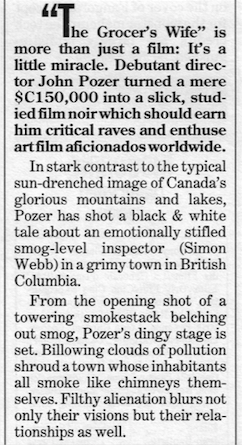I first drove into the city of Trail, British Columbia, in 1986. The huge smelter was roaring; the air was swirling with smoke: and the radio news was in Italian. I had lived in British Columbia all my life but I’d never experienced anything like this: I felt lost, frightened and small. I was a stranger here.
The smelter in Trail sits atop a hill overlooking the town. It reminded me of the Acropolis of Athens, but re-imagined as a post-industrial nightmare. Being curious, I signed up for a tour through the factory, venturing down into the bowels of the operation where hot molten steel was processed and poured. The guide spoke about the environmental damage to the surrounding area, the “heavy water” plant that contributed to the making of atomic bombs, and the fact that Trail was on Hitler’s top ten ‘hit list’ of North American cities.
The Smelter in Trail, British Columbia

I happened upon this notorious little town by accident. I was taking a different route back to Vancouver, returning from a film shoot in the mountain town of Nelson where I’d been a director-observer on Scottish director Bill Forsyth‘s film Housekeeping. I was enrolled in the Masters Film Production program at the University of British Columbia and I had a goal to make a feature film for my thesis. Driving through the streets of Trail, I knew I had found the setting.
I returned with my actors and crew in the summer of 1989. We shot black and white 16mm film and re-photographed every finished frame to 35mm. The result is rich and grainy, like looking at the world through densely-particled air. The Grocer’s Wife went on to premiere at the Toronto International Film Festival in 1991 where it was recognized with a special jury citation for Best Canadian Film. In 1992, it was selected to open the International Critic’s Week at Cannes.
The Architectural Intention of my Compositions
At a Q+A following a matinee screening at Cannes, a young French cinephile (who couldn’t have been older than 15) asked me ‘to explain the architectural intention of my compositions.’ I had done extensive research on this topic, but it wasn’t something I thought would translate in my film. I recounted my first impressions of Trail and how the smelter was built at a site that would have have historically been used for sacred religious architecture, like the Acropolis or Le Corbusier’s chapel at Ronchamp, France.
Religious architecture, in the Canadian context, diminished in scope and scale as the country expanded to the west. In Montreal, you see grand church steeples, domes and basilicas throughout the city. In Vancouver, the historic churches are few and tiny in comparison.
Technological Nationalism
Western Canada was settled by the construction of the national railroad and the pervasive spread of industrial mechanization. Factories replaced churches as the center of towns; shift whistles replaced church bells; smokestacks replaced steeples. The absence of religious architectural landmarks and the re-organization of communities around machines changed the dominant values of society and created new psychological distortions: alienation, isolation and normlessness.
I could never truly capture my first impression of discovering Trail, but it had such an impact that I had to try. The Pacific Cinematheque will be screening a DCP of the 35mm print, courtesy of the National Library and Archives, as part of their History of Film in British Columbia program on April 3rd. Screening time and info.


